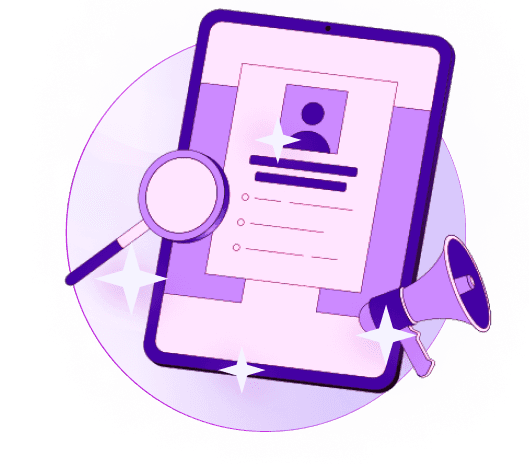Blogs
Articles

What is Lead Enrichment in Sales?
Sales teams report that only 44% of marketing qualified leads (MQLs) show real promise. Your marketing team works tirelessly to generate leads, yet nowhere near half of them convert!
Lead enrichment enhances simple lead information with additional data to create detailed prospect profiles. Lead enrichment tools help teams turn simple contact details into rich profiles that substantially improve sales approaches.
Let's take a closer look at everything about lead enrichment. We'll cover what it means, why it matters to your business, different types of enrichment data, and ways to implement it effectively.
What is Lead Enrichment in Sales?
Lead enrichment helps you get into simple lead information and add more data points and insights. Your original lead data has only names and email addresses, and lead enrichment fills gaps by adding valuable information about prospects and their companies.
The process adds important information to lead records and speeds up qualification and routing. Lead enrichment gathers, organizes, and analyzes data about your customer's interest in what you offer. This extra context helps marketing and sales teams create tailored experiences that turn leads into customers faster.
Companies use lead enrichment to build detailed profiles of each lead and create targeted communication strategies. The enriched data shows a lead's potential value clearly, which helps teams focus on high-quality prospects.
What is lead in the sales process?
A sales lead represents a person, department, or company that could buy your product or service and has the authority to make purchases. Your sales process needs leads - you simply can't sell anything without them.
Leads sit right at the top of the sales funnel. They've connected with your company and know about your business, but nobody has qualified them yet. These leads haven't shown they're a good fit for your solutions, unlike prospects.
Why Lead Enrichment Matters for Sales Teams?
Sales teams face a challenging digital world where every potential deal counts. The competitive environment makes lead enrichment a vital advantage for sales professionals who aim to optimize efficiency and results.
Sales productivity jumps 25% higher when companies implement advanced lead enrichment strategies, and they close deals 30% faster. Sales representatives achieve these improvements through accurate, detailed lead information that eliminates research time waste.
Enriched leads show remarkable conversion rates. They become customers 2-3 times more often than those with simple contact details. Companies that use effective lead enrichment see up to 77% higher ROI on their sales efforts.
These dramatic improvements have clear reasons. Your team might join the 80% of businesses struggling to generate quality leads without enrichment. Companies lose about 12% of revenue annually due to poor data quality, while enriched data helps increase sales by 5-10%.
Are there any other ways to enrich my data in real-time?
AI-powered systems have revolutionized sales data enrichment beyond traditional processes. Manual data tasks have evolved into smart automated systems that provide better insights with minimal human input.
Sales reps now work with fresh, verified data right in their CRM through real-time enrichment. This approach is substantially different from batch processing because companies can respond quick to shifts in customer behavior and market dynamics.
Here are the most effective ways to enrich data in real-time:
AI and automation tools check and verify contact details continuously. These tools complete detailed lead enrichment within 30-60 seconds. Natural Language Processing helps extract valuable data from emails, social media posts, and website interactions.
Integration platforms such as LeadsBridge directly connect lead sources to your CRM to speed up enrichment. Modern tools use AI to collect rich data about potential customers, which helps businesses discover new leads and spot opportunities to connect.
Social profile enrichment looks at LinkedIn, Twitter, or company websites to track job changes, company updates, or mutual connections that add a personal touch to outreach.
The results speak for themselves - 72% of companies using AI lead enrichment report better data completeness. These live methods keep data accurate even as information quickly becomes outdated.
Why is lead enrichment important for your business?
Lead enrichment is the life-blood of modern business success that goes well beyond boosting sales numbers.
Your teams can get a complete view of potential customers through effective lead enrichment. This process solves the problem of incomplete data that affects almost every organization. Teams can then create targeted campaigns and segment markets with precision.
Good lead enrichment also improves customer experience throughout the customer's trip by a lot. Rich data helps you understand your prospects' specific needs. This understanding lets you personalize interactions that feel genuine rather than generic. Your personalized approach builds trust and creates meaningful connections right from the start.
Many businesses don't deal very well with operational inefficiencies. Without proper lead enrichment, teams waste valuable hours looking up simple information instead of focusing on activities that propel development.
Markets often have similar products competing against each other. Companies with better customer insights stand out from the crowd. Lead enrichment gives these vital insights and helps you identify unique selling points that strike a chord with specific customer segments.
Rich lead data helps make smart business decisions beyond sales. Marketing strategies, product development priorities, and resource allocation all benefit from the detailed understanding of potential customers that comes from lead enrichment.
Types of Lead Enrichment Data
Lead enrichment success depends on gathering and analyzing several types of data to build detailed prospect profiles. Each data type plays a unique role in your sales strategy.
Contact and demographic data
Names, email addresses, phone numbers, and social media profiles make up the basic contact data that powers any prospecting strategy. Mobile phone numbers have become valuable assets since remote work became common. They let sales teams reach prospects directly without dealing with gatekeepers.
Your leads' personal details make up the demographic data. This data has information about age, job title, seniority, gender, income, education level, and role in the organization. These details help create accurate customer profiles and let you personalize your outreach. B2B purchases need multiple stakeholders' approval, so understanding your prospect's background and authority is vital.
Firmographic and technographic data
A company's blueprint comes from firmographic data. It shows key details like industry type, company size based on employees and revenue, location, business structure, and when the company started. This data helps you see if potential customers match your ideal customer profile.
Technographic data shows the technology stack a prospect's company uses. The stack consists of software, hardware, cloud services, programming languages, and IT setup. Your team can spot compatibility issues, find integration opportunities, and create targeted pitches when they know a company's technology needs.
Intent and behavioral data
Digital footprints like web searches, content views, website visits, and product research reveal intent data. Companies that use intent-qualified leads close their deals 30% faster than those using regular leads.
Behavioral data tracks how prospects interact with your company. It monitors website visits, email responses, content downloads, and event participation. Companies can predict conversions by analyzing these patterns. Businesses using behavioral analytics see their conversion rates improve by 79%.
Geographic and social media data
Geographic data pinpoints where prospects and their companies are located. This helps create region-specific offers and content. Sales teams use this information to plan local marketing, follow regional rules, and manage logistics.
Social media activity provides a window into prospects' interests, activities, connections, and engagement. This information helps create targeted account-based marketing campaigns that match prospects' professional interests.
How Lead Enrichment Works in Practice?
Lead enrichment follows a well-laid-out four-step process that turns simple contact information into valuable sales intelligence.
The first step focuses on data collection to gather complete information about leads. While manual collection works, most B2B teams use AI data enrichment tools to work faster. These tools extract verified information from trusted sources and fill gaps in your database.
The process moves to scoring and segmentation that uses firmographic, technographic, and behavioral criteria. This vital step helps teams prioritize valuable prospects and customize their messaging.
Smart lead routing will give sales representatives the right leads based on territory, expertise, or deal value. Automated systems prevent leads from getting lost and help teams follow up quickly.
The final stage uses enriched data to create individual-specific outreach. Sales teams can craft targeted messages that address specific pain points and needs with detailed profiles.
To improve your entire lead enrichment process with powerful automation, check out Persana – a solution that bridges the gap between raw data and practical intelligence.
What are the examples of lead enrichment?
Companies of all sizes have seen remarkable results with lead enrichment. UserEvidence shows what's possible - they used Cognism to enrich their accounts with accurate contact data and increased their pipeline by 33% in just three months. This helped them create customized outreach that appealed to prospects.
The results at HubSpot tell a similar story. They achieved 45% higher conversion rates through better lead enrichment. Their success came from finding high-intent prospects and customizing their approach.
Caterpillar's story proves lead enrichment works in traditional sectors too. They used ZoomInfo and Clearbit to power their account-based marketing and got 25% more sales-qualified leads. Their sales cycle became 15% shorter.
Lead enrichment serves different purposes for each team. Marketing teams use it to segment webinar sign-ups by industry. Sales teams rely on verified emails for outbound sequences. Customer success teams keep their contact records fresh to stay connected with new decision-makers.
These real-world examples show how enriched data turns prospecting from guesswork into precise targeting.
How does lead enrichment work?
Lead enrichment mechanics work through sophisticated data processing systems that turn simple contact information into complete profiles. The process matches partial lead data against extensive databases with billions of data points from millions of companies.
The enrichment process starts as soon as a new lead enters your system through website forms, email sign-ups, or imported lists. Your lead's existing information creates a "data fingerprint" that enrichment tools match against their databases.
These specialized systems use advanced matching algorithms and machine learning to identify and extract relevant information accurately. The software pulls additional data points like company size, industry, technologies used, and relevant contact details by analyzing email domains and company names.
Modern lead enrichment tools connect to your CRM through API integrations. The system looks up data immediately when new leads arrive. This ensures sales representatives see complete profiles without manual work.
Enrichment tools can process thousands of records at once to handle large datasets. They flag duplicates, fix inconsistencies, and standardize data formats throughout your database. Sales representatives save up to 40% of their time that they previously spent on manual research.
Conclusion
Lead enrichment gives sales teams a powerful way to optimize efficiency and achieve better results. This piece shows how turning simple contact information into detailed prospect profiles boosts conversion rates and speeds up sales cycles. Companies that implement these strategies gain real advantages—from 25% higher sales productivity to 30% faster deal closures.
Numbers tell the story clearly. Enriched leads convert 2-3 times more often than those with minimal information. Businesses using effective enrichment see up to 77% higher ROI on their sales efforts. Quality lead generation remains a core challenge for 80% of businesses.
Contact and demographic details serve as the foundation. Firmographic and technographic insights reveal organizational fit. Intent and behavioral signals show readiness to buy. Geographic and social information enables local targeting. These elements combine to paint a complete picture of each potential customer.
Success comes from a well-laid-out process: data collection, scoring and segmentation, proper routing, and customized nurturing. Companies like UserEvidence, HubSpot, and Caterpillar demonstrate measurable results in businesses of all sizes.
Sales teams can focus on building relationships and closing deals instead of researching simple prospect information. Detailed customer insights provide a competitive edge in crowded markets where similar products vie for attention.
AI-powered systems now deliver richer insights with minimal human intervention. These simplified processes ensure teams always work with current, verified information right in their CRM.
FAQ
What does lead enrichment mean?
Lead enrichment makes your simple lead data better by adding valuable insights and information. It turns basic prospect details into rich customer profiles by automatically filling in missing information. This creates a complete picture of each lead. Companies can then personalize their communication and strategies to connect with prospects.
What is lead enrichment for CRM?
Lead enrichment in CRM systems makes your customer data more valuable. The process pulls external data from multiple sources and adds it to your CRM's lead records. Lead enrichment tools can gather and update contact details, company insights, and buying intent data automatically. This reduces manual work and keeps your information accurate.
What is enrichment in sales?
Sales enrichment adds depth to your prospect information. Your sales team needs demographics, company details, and behavioral data to understand customer needs better. This helps them customize their approach to each potential customer. The focus stays on gathering and organizing information that matters for sales.
How do you automate lead enrichment?
The automation process starts by linking enrichment tools to your CRM through custom integrations. You'll need to set up specific triggers, such as new lead creation or data updates. The system then pulls data from multiple sources automatically. It updates lead records live and scores leads based on the enriched data.

Create Your Free Persana Account Today
Join 5000+ GTM leaders who are using Persana for their outbound needs.
How Persana increases your sales results
One of the most effective ways to ensure sales cycle consistency is by using AI-driven automation. A solution like Persana, and its AI SDR - Nia, helps you streamline significant parts of your sales process, including prospecting, outreach personalization, and follow-up.



